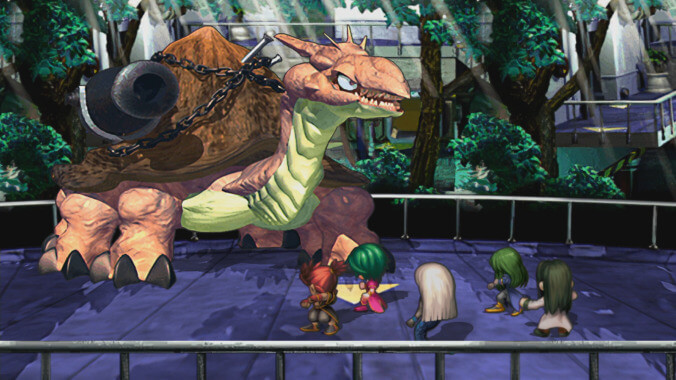Square Enix’s latest effort in its seemingly endless crusade to rehash its back catalogue on behalf of an audience either too damn young, or too damn nostalgic, to know any better—you’d be forgiven for thinking, “Woof, that must just be how they made them back then!” “Thank god,” you, a hypothetical incorrect person, will subsequently think. “We’ve moved past an era where it was acceptable for an RPG to leave major game mechanics woefully under-explained. Or to give players zero indication of where their next destination in the massive game world should be. Or to let huge chunks of a game’s mechanics—difficulty, character growth, the placement of boss fights, etc.—be determined randomly, turning every potential battle into a vicious and dispiriting roulette wheel of death!”
But do not be fooled, hypothetical incorrect person—despite that being your designated and only role in the hypothetical thought experiment in which you exist. SaGa Frontier is not an indictment of the game design trends of 1998, the year it arrived in American homes cloaked in the still-glimmering halo effect of Square’s massively successful Final Fantasy VII. No, SaGa Frontier—Remastered or otherwise—is only and ever a SaGa game, the strangest tributary of all of the little rivers running off Square’s wildly popular Final Fantasy franchise.
(A history, in brief: When designer Akitoshi Kawazu, fresh off the warm reception his battle system received after being implemented in the original Final Fantasy, sat down to create its successor for Final Fantasy II, he decided to get a little innovative. Aiming at realism, or at least “realism,” Kawazu implemented a system where characters gained stats based on the specific actions they took in fights: Attack a bunch, raise your Strength; cast a bunch, raise your Magic; get hit a bunch, raise your maximum Health. This idea turned out to be a) neat, and b) badly broken, a mantra that would become the watchword for basically all of the SaGa games that Kawazu was eventually given to keep him from getting dangerously “creative” with the company’s bread and butter Final Fantasy franchise ever again.)
The deeply irritating thing about the SaGa games, then and now, is that they’re usually too interesting and ambitious to just write off as “bad.” (With the exception of 2002’s Unlimited SaGa, which is literally played by running a slot machine for every single thing you do, and is correspondingly infuriating.) And SaGa Frontier, which claims as its major innovation the ability to choose from one of several protagonists to take through individual stories set in a staggering array of shared locations, is not a bad game. But it is a frustrating game. And a grindingly difficult game. And an almost malevolently obtuse one. It’s worth noting that Remastered, arriving this week on Windows, PS4, Switch, iOS, and Android, contains new tools clearly designed to make its story easier to follow and its hidden array of trigger events more clear, and it’s still damned easy to lose your way. The actual world is beautiful and weird—if also still pretty poorly translated— and the incredible chunkiness of the game’s battle mechanics manages to be compelling, even as it kills you with seemingly cruel and random indifference. But a few quality of life improvements (including on-demand quick-saving, speed controls, and a few other welcome additions) can’t make up for all of SaGa Frontier’s sometimes maddening quirks.
The other improvements in the package are more subtle. One of the seven original scenarios gets a few new scenes, an additional character planned for the PS1 version gets added back in, and the game’s visuals have been given the standard clean-up. The most notable improvements come in the fights, where the monsters—whose bright, glossy 3D models carry the look of beautiful and bizarre stop-motion figurines—absolutely shine, even as they’re cheerfully kicking your teeth in. But really, the most impressive(?) thing about Remastered is how hands-off it is; there have been very few concessions to what a strange, broken, occasionally thrilling game Kawazu and his team crafted 20-plus years ago. If you want to stick your head in this particular hole—and god knows plenty of people did, back in the day—then a certain kind of reward is available to be reaped in abundance. Just don’t blame its frustrations on the era in which it was made. SaGa Frontier’s weirdness is, and was, a beast all its own.


 Keep scrolling for more great stories from A.V. Club.
Keep scrolling for more great stories from A.V. Club.